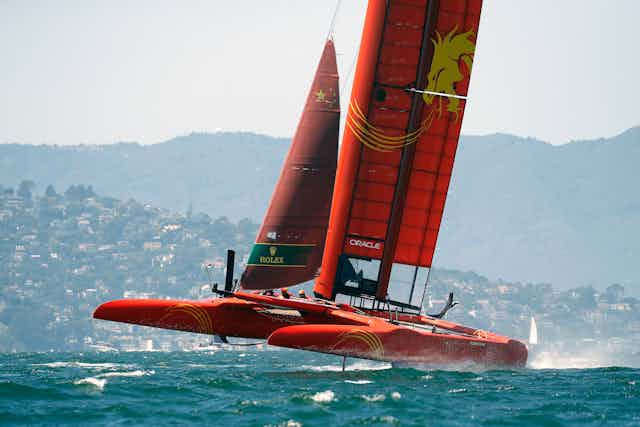

Sail GP: how do supercharged racing yachts go so fast? An engineer explains
Head of Engineering, Warsash School of Maritime Science and Engineering, Solent University
Disclosure statement
Jonathan Ridley does not work for, consult, own shares in or receive funding from any company or organisation that would benefit from this article, and has disclosed no relevant affiliations beyond their academic appointment.
View all partners
Sailing used to be considered as a rather sedate pastime. But in the past few years, the world of yacht racing has been revolutionised by the arrival of hydrofoil-supported catamarans, known as “foilers”. These vessels, more akin to high-performance aircraft than yachts, combine the laws of aerodynamics and hydrodynamics to create vessels capable of speeds of up to 50 knots, which is far faster than the wind propelling them.
An F50 catamaran preparing for the Sail GP series recently even broke this barrier, reaching an incredible speed of 50.22 knots (57.8mph) purely powered by the wind. This was achieved in a wind of just 19.3 knots (22.2mph). F50s are 15-metre-long, 8.8-metre-wide hydrofoil catamarans propelled by rigid sails and capable of such astounding speeds that Sail GP has been called the “ Formula One of sailing ”. How are these yachts able to go so fast? The answer lies in some simple fluid dynamics.
As a vessel’s hull moves through the water, there are two primary physical mechanisms that create drag and slow the vessel down. To build a faster boat you have to find ways to overcome the drag force.
The first mechanism is friction. As the water flows past the hull, a microscopic layer of water is effectively attached to the hull and is pulled along with the yacht. A second layer of water then attaches to the first layer, and the sliding or shearing between them creates friction.
On the outside of this is a third layer, which slides over the inner layers creating more friction, and so on. Together, these layers are known as the boundary layer – and it’s the shearing of the boundary layer’s molecules against each other that creates frictional drag.
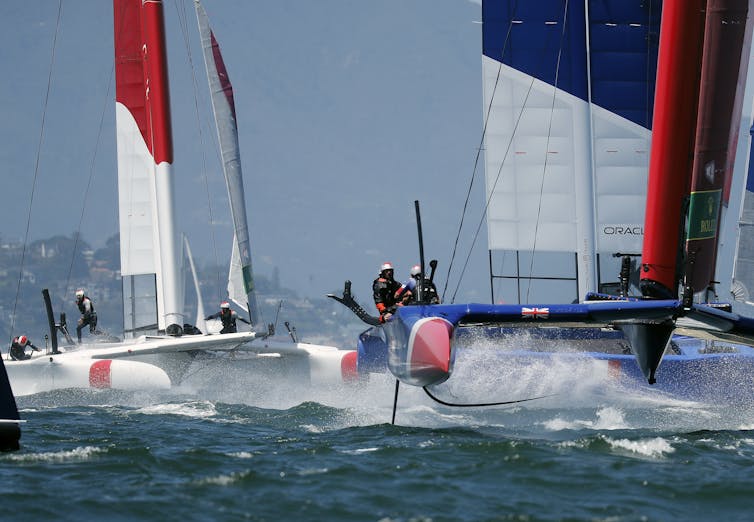
A yacht also makes waves as it pushes the water around and under the hull from the bow (front) to the stern (back) of the boat. The waves form two distinctive patterns around the yacht (one at each end), known as Kelvin Wave patterns.
These waves, which move at the same speed as the yacht, are very energetic. This creates drag on the boat known as the wave-making drag, which is responsible for around 90% of the total drag. As the yacht accelerates to faster speeds (close to the “hull speed”, explained later), these waves get higher and longer.
These two effects combine to produce a phenomenon known as “ hull speed ”, which is the fastest the boat can travel – and in conventional single-hull yachts it is very slow. A single-hull yacht of the same size as the F50 has a hull speed of around 12 mph.
However, it’s possible to reduce both the frictional and wave-making drag and overcome this hull-speed limit by building a yacht with hydrofoils . Hydrofoils are small, underwater wings. These act in the same way as an aircraft wing, creating a lift force which acts against gravity, lifting our yacht upwards so that the hull is clear of the water.

While an aircraft’s wings are very large, the high density of water compared to air means that we only need very small hydrofoils to produce a lot of the important lift force. A hydrofoil just the size of three A3 sheets of paper, when moving at just 10 mph, can produce enough lift to pick up a large person.
This significantly reduces the surface area and the volume of the boat that is underwater, which cuts the frictional drag and the wave-making drag, respectively. The combined effect is a reduction in the overall drag to a fraction of its original amount, so that the yacht is capable of sailing much faster than it could without hydrofoils.
The other innovation that helps boost the speed of racing yachts is the use of rigid sails . The power available from traditional sails to drive the boat forward is relatively small, limited by the fact that the sail’s forces have to act in equilibrium with a range of other forces, and that fabric sails do not make an ideal shape for creating power. Rigid sails, which are very similar in design to an aircraft wing, form a much more efficient shape than traditional sails, effectively giving the yacht a larger engine and more power.
As the yacht accelerates from the driving force of these sails, it experiences what is known as “ apparent wind ”. Imagine a completely calm day, with no wind. As you walk, you experience a breeze in your face at the same speed that you are walking. If there was a wind blowing too, you would feel a mixture of the real (or “true” wind) and the breeze you have generated.
The two together form the apparent wind, which can be faster than the true wind. If there is enough true wind combined with this apparent wind, then significant force and power can be generated from the sail to propel the yacht, so it can easily sail faster than the wind speed itself.
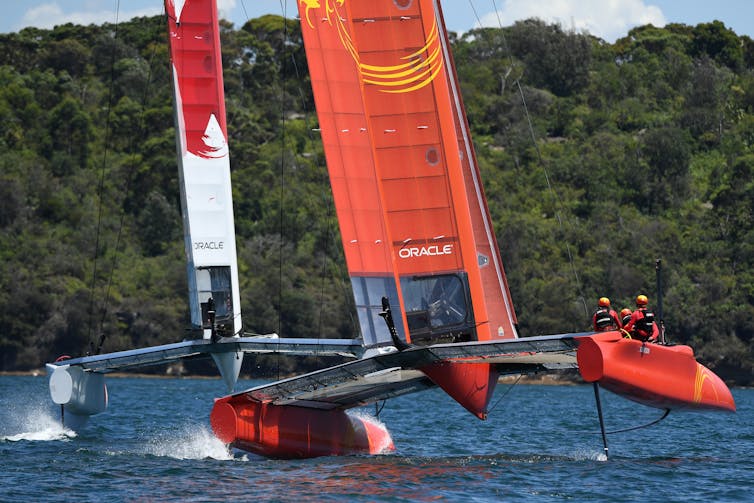
The combined effect of reducing the drag and increasing the driving power results in a yacht that is far faster than those of even a few years ago. But all of this would not be possible without one further advance: materials. In order to be able to “fly”, the yacht must have a low mass, and the hydrofoil itself must be very strong. To achieve the required mass, strength and rigidity using traditional boat-building materials such as wood or aluminium would be very difficult.
This is where modern advanced composite materials such as carbon fibre come in. Production techniques optimising weight, rigidity and strength allow the production of structures that are strong and light enough to produce incredible yachts like the F50.
The engineers who design these high-performance boats (known as naval architects ) are always looking to use new materials and science to get an optimum design. In theory, the F50 should be able to go even faster.
- Engineering
- Aerodynamics

Project Manager SSTP

Head of Evidence to Action

Supply Chain - Assistant/Associate Professor (Tenure-Track)

OzGrav Postdoctoral Research Fellow

Casual Facilitator: GERRIC Student Programs - Arts, Design and Architecture
How SailGP’s foiling F50 catamarans sail so much faster than the wind

Arguably the most technologically advanced sailboats on the planet right now, the one-design SailGP F50 foiling catamarans are capable of breathtaking speeds – at times, reaching four times the velocity of the wind that drives them. But how do they do it?
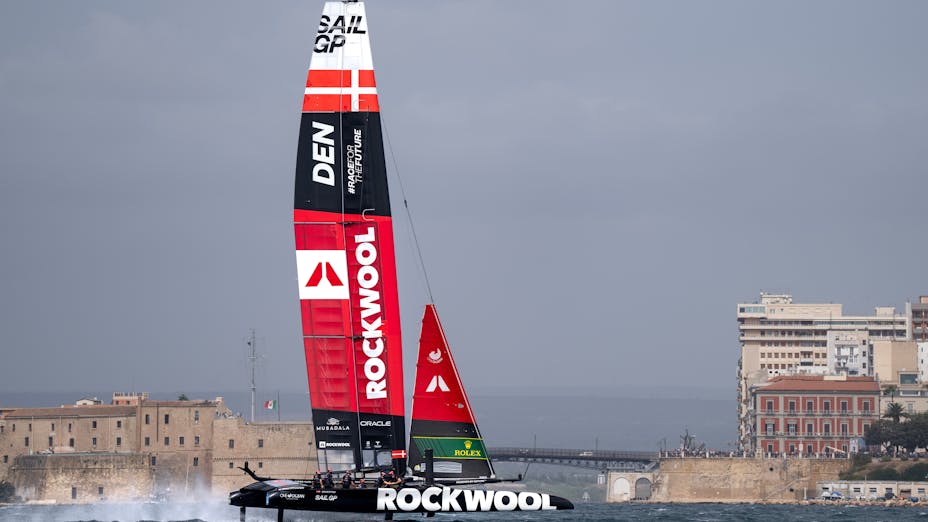
Beating the balloon

Bending the laws of physics

Faster and faster

Beneath The Surface
Watch on youtube.
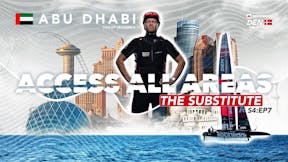
Access All Areas
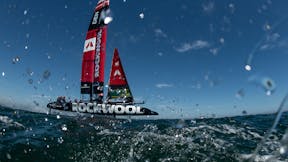
Want to learn more about SailGP?
Meet the denmark sailgp team, find all the latest news, go beneath the surface of sailgp, sailing terms, go beneath the surface.
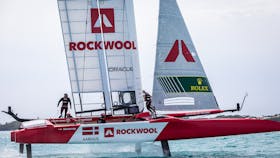
How the world’s fastest sail racing boats fly above the water
Tune in to SailGP’s landmark Season 2 opener in Bermuda at the end of the month, and you’d be forgiven for thinking that your eyes are deceiving you.
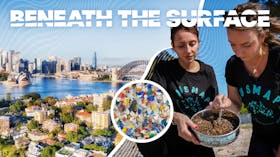
The Beneath The Surface show
We go Beneath The Surface of SailGP's iconic host cities, set a spotlight on great projects and curious mind and catch all the lastest with the Denmark SailGP Team. Join us as we travel the world and explore how innovation and science is helping solve the world's biggest challenges!
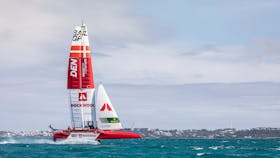
This is how SailGP's NASA-inspired wings make the F50 boats fly
Some may say the foils, which help the boats to fly above the water. Others may claim it’s the platform – that’s the two, catamaran hulls and the trampoline that connects them.
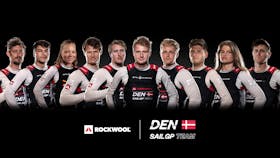
ROCKWOOL Denmark SailGP Team
The official home of the ROCKWOOL Denmark SailGP Team. Meet the team, read all the latest stories and explore a world of exciting content.

ROCKWOOL Group
F1x A-class foiling catamaran
World champion, lighter = better, craftsmanship, meet the foiling f1x a-class catamaran.
This is the ultimate singlehanded foiling catamaran of the moment: ultramodern, incredibly fast, very agile, extremely strong and feather-light, in an aerodynamic and ergonomic design. The perfect total package, packed in 1 foiling catamaran. This is the world’s coolest boat for singlehanded races and the winner of several A-cat world championships and many other sailing races.
The 2020-F1x A-cat is exactly the same foiling catamaran that made Mischa Heemskerk Vice-World Champion at the Herveybay Worlds 2018 in Australia and World Champion at Weymouth 2019. All our foiling F1x A-class catamarans come straight, ready to race and ‘Mischa-tuned’ from our factory.
Unique design enables top performances
The F1x A-class foiling catamaran is the ultimate reflection of our current design language. The aerodynamic design accentuates the performance qualities of this super fast foiling racing boat. The sophisticated deck plan provides clear control and minimal air resistance.
Foils The rudders and daggerboard foils used on the F1x A-class foiling catamarans are produced with the highest quality carbon pre-preg fibers. The foils are cured in our own Autoclave . Our winning foil design was created in close cooperation with Glenn Ashby and the designers of AC Team New Zealand .
Construction The F1x A-cat is manufactured entirely according to the carbon pre-preg/ Nomex production method, and cured in our Autoclave. This technology is the same as used in the aerospace industry and within other foiling boats like for example, the America’s Cup.
Design The design of the F1x foiling A-class catamaran was completely conceived by the DNA design team and made at DNA’s own yard. In the DNA design team Pieterjan Dwarshuis, Mischa Heemskerk and the renowned Dutch industrial design engineer Rudo Enserink worked closely together to create the perfect foiling A-class catamaran.
We build your new foiling boat!
Technical details.
The F1x A-class foiling catamaran has a number of unique features that improve performance. For example:
- Semi ridged trampoline. Gives extra torsional stiffness to the boat and increases its aerodynamic characteristics.
- Patented main-sheet-wheel-system. For more direct and faster trim of the main sail.
- Aerodynamically placed traveller car.
- Flexible daggerboard casings. For minimal water absorption in floating mode.
- Aerodynamically shaped ‘beams’.
- Adjustable T-rudders. Foiling with rudder differential is possible.
Specifications
LOA: 5.49 m BOA: 2.30 m Max. draught: 1.20 m Sail area: 13.94 m Total weight: ca. 53 kg Top speed: 31 kn Extra: All measurements according to IACA Class regulations.
Buy a champion's boat!
Are you excited to buy a F1x A-class foiling catamaran from DNA Performance Sailing? Please fill in our contact form:
Yes, I want a F1x A-cat!
Schrijf je in voor onze nieuwsbrief en blijf op de hoogte van de nieuwste ontwikkelingen.
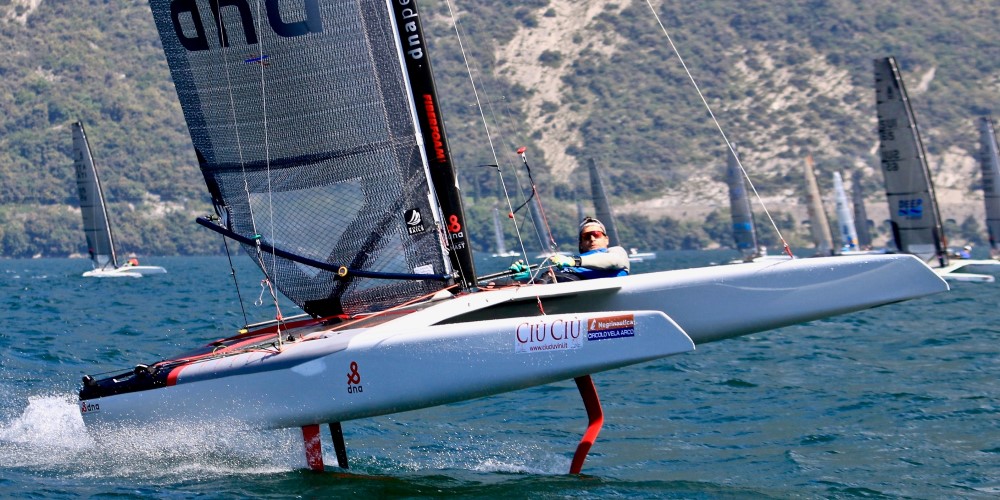
Contactformulier
- Company Name
- Full name * First Last
- Emailaddress *
- Phonenumber *
- Mijn vraag betreft * My question: TF10 F1x G4 F4 Custom Parts Hydrofoils Other
- Phone This field is for validation purposes and should be left unchanged.
Registrieren Sie sich für unseren Newsletter
lassen Sie sich über die neuesten Entwicklungen informieren!
- E-Mail-Adresse *
Schrijf je in voor onze nieuwsbrief
blijf op de hoogte van de nieuwste ontwikkelingen!
- First name *
- Last name *
- Email This field is for validation purposes and should be left unchanged.
Wij gebruiken cookies om u de beste online ervaring te bieden. Door akkoord te gaan, accepteert u het gebruik van cookies in overeenstemming met ons cookiebeleid.
Wanneer u een website bezoekt, kan deze informatie in uw browser opslaan of ophalen, meestal in de vorm van cookies. Beheer hier uw persoonlijke cookiediensten.
- wordpress_test_cookie
- wordpress_logged_in_
- wordpress_sec
F50 Hydrofoils: Racing The World's Most Advanced Sailboats

What Apple Should Copy From Google's Pixel Event

I Toured a Virtual Power Plant

iPhone Features You Need to Try On Your Next Trip

6 Months With the Vision Pro: Was It Worth It? (Real Owners React!)

Driving 4,000 Miles in Lotus' New EV Was Brutal and I Loved It

The Galaxy S24 Ultra With Samsung DeX Replaced My Laptop

See Inside Rivian's Electric Vehicle Test Labs

Apple's AI at WWDC Will Take a Different Twist

Travel Advice from AI? The Points Guy Schools ChatGPT

Apple TV Just Leveled Up with the RetroArch App

The Apple Core

Alphabet City

The Daily Charge

What the Future

Cooley On Cars

Latest News

Apple's iPhone 16 Glowtime Event: What We Expect

One More Thing: Don't Buy Apple Products Right Now

Unitree's $16K Humanoid Robot Leaps Toward Production

Revive Slow Gigabit Speeds Without Panicking

I Played Capcom's Upcoming Game Monster Hunter Wilds at Gamescom

Avowed is a Funny and Action-Packed RPG at Gamescom

What To Do With a Security Breach?

Apple's Big Blunders a Decade Ago: U2, Bendgate, Botched iOS 8

Assassin's Creed: Shadows Is the Class of Ubisoft's Iconic Game Franchise

The First Berserker Khazan is My Favorite Game at Gamescom, So Far
Yachting World
- Digital Edition

Foiling and Hydrofoiling: Everything you need to know

A foiling International Moth dinghy. Photo: Christopher Ison / Alamy
What is foiling?
Although foiling or hydrofoiling feels like a recent revolution to take the world of watersports by storm, it is actually much older than many appreciate.
In terms of motorised waterborne craft, the first foiler was a motorboat designed and built by Italian inventor Enrico Forlanini in 1906.
It did, however, take quite a bit of time before foiling boats with sails took to the water, but even then many people might be surprised to learn that even in the 1970’s the foiling trimaran, Williwaw, covered over 20,000 sea miles in and around the South Pacific all on its foils.
It turns out the history of hyrofoiling goes back further than many think.
It was not until the early-2000s that foiling really started to take hold, with a development dinghy class, the International Moth, leading the way.
Foiling boats
With huge amounts of interest in the 11ft Moth dinghy, foiling began to spread throughout the sport of sailing. And it was not long until hydrofoiling boats of all different shapes and sizes were taking the water.
Over time, some traditional classes converted to foiling – the A-Class and C-Class catamarans being examples. But more new boats were also designed specifically with hydrofoiling in mind.
In 2013 Emirates Team New Zealand built their 72ft America’s Cup catamaran to be a foiler, forcing their competition for the Cup, Oracle Team USA to convert their AC72 into a foiler to stay competitive – ultimately Oracle Team USA won the Cup in one of the biggest sporting comebacks of all time .
To date the America’s Cup has not looked back with the competition taking place in smaller hydrofoiling AC50 catamarans in 2017 and the newly conceived monohull foilers, the AC75 s, in 2021.
In 2021 the Olympics Games introduced the first ever foiling catamaran in the Nacra 17.
Foiling yachts
Offhsore, 90ft Ultime multihulls on their foils are competing to be the fastest to race around the globe and design houses across the globe are racing to create foiling yachts for the masses which could dramatically reduce cruising times from one destination to the other.
There are also many classes of yacht that are taking some of the lessons from fully foiling craft and putting them to use in a semi-foiling manner.
Here the biggest technical innovation is in the IMOCA60 class, which is famously used for the single handed non-stop round the world race, the Vendée Globe .
The latest couple of generations of IMOCA 60s have been build with huge, technologically complex foils to generate lift. These are powerful enough to lif the boats fully out of the water, but as yet the class rules do not allow for rudder foils which would stabilise flight and allow for full foiling.
Where sailing boats and yachts have, arguably led the way in the history of foiling over the past decade or so this has filtered down into a plethora of other watersports craft.
Although in the early days foiling was typically the preserve of elite sailors and watersports professionals, increasingly we have seen boats and boards designed to foil in the hands of the average sailor, surfer or windsurfer.
This race to bring the fun of foiling to beginners is continuing apace with beginner foiling boats, windsurfers, surfers etc. coming to the market every year.

How to watch today’s America’s Cup today’s Preliminary Regatta live streams from anywhere
- August 23, 2024
The America’s Cup Louis Vuitton Preliminary Regatta will start on Thursday 22 August 2024 and will run through until Sunday 25 August 2024 and will see all all six teams…

The 10 best foiling dinghies: fun ways to get flying for all abilities
- July 16, 2024
Foiling used to be the preserve of a select few elite-level athletes, but a couple of decades of work by enthusiasts determined to broaden participation has resulted in a slew…

12 dream sailing experiences – from dreamy adventures to high-octane thrills
- May 15, 2024
We’re all seeking experiences. Whether that’s taking on a sporting challenge, going on above-averagely-adventurous holidays, or learning a new hobby or skill, we live in an era where ‘doing’ is…

Ainslie’s team reveals Britain’s new America’s Cup boat
- April 20, 2024
The British America’s Cup team has become the fourth challengers to unveil their new AC75. INEOS Britannia revealed their AC75 in the early hours of morning, as the foiling monohull…

World’s coolest yachts: Monitor – the 1955 foiling boat
- February 29, 2024
“It has to be Monitor, of course! The father of all flying rockets!” says Desjoyeaux. One of the world’s first sailing hydrofoils, Monitor was created in 1955 by Gordon Baker,…

North Atlantic in six days solo: Arkea Ultim Challenge leaders cross the Equator
- January 13, 2024
Less than a week after setting out from the start in Brest, the leading Ultim trimarans in the Arkea Ultim Challenge have crossed the Equator. First to enter the Southern…

Six solo skippers ready to race 100ft foiling multihulls around the world
- January 4, 2024
There are very few ‘firsts’ left in the world of sailing, but one such remaining barrier could be smashed when the Arkea Ultim Challenge Brest sets off from north-west France…

How to turbo-charge a round the world racer
- November 28, 2023
Ahead of me, the bow of Medallia is pointing at the sky. This is not poetic license; I am actually looking upwards at my bowsprit as it rises up, 50ft…

Slingsby and Neuschäfer crowned Sailors of the Year 2023
- November 15, 2023
The 2023 Rolex World Sailor of the Year awards were presented to Tom Slingsby and Kirsten Neuschäfer last night at a ceremony by World Sailing in Málaga, Spain. The popular…

Le Cléac’h and Josse win the 2023 Transat Jacques Vabre
- November 13, 2023
French duo Armel Le Cléac’h and Sébastien Josse sailing Maxi Banque Populaire XI have won the Transat Jacques Vabre 2023, crossing the finish line at 18:19hrs local time (22:19hrs UTC)…

We’re astounded by this new foiling superyacht: Baltic 111 Raven
- October 19, 2023
Wow…! This foil-assisted, ultra-lightweight superyacht breaks new ground in many respects and Baltic says it is “one of the most extreme yachts” the yard has built in its 50-year history.…


5 reasons to follow the 30th anniversary Transat Jacques Vabre
- October 12, 2023
The Transat Jacques Vabre is one of the ultimate tests of short-handed racing, a double-handed dash from France that sees many of the world’s top racing machines take on the…

World’s fastest monohull: Malizia-Seaexplorer IMOCA 60
- August 17, 2023
Followers of the IMOCA 60 fleet will know that two names have dominated the class over the past two generations when it comes to design: VPLP and Verdier. So, it’s no…

IMOCAs win race to Cherbourg with Macif first monohull in Rolex Fastnet Race
- July 24, 2023
In the battle of the big boats it was the brand new IMOCA Macif, skippered by Charlie Dalin with Pascal Bidégorry which was first monohull home to take line honours in…

Rolex Fastnet Race 2023 stacked IMOCA fleet set to entertain
- July 20, 2023
The famous Rolex Fastnet Race always provides an intriguing line up of amateur and professional teams all looking for race glory as they battle the 629nm course from Cowes, round…

Two giant foiling trimarans set for a Fastnet Race battle
- July 18, 2023
As with most big races around the world, bragging rights in the Rolex Fastnet Race race are split into two broad camps, the line honours winners (the first boat to…

First look: Persico 72ft 40-knot foiling cruising cat
- July 7, 2023
The new foiling catamaran design is the result of Persico’s strategy to translate knowledge the yard gains from its work in aerospace, IMOCA 60 and America’s Cup spheres into very…

11th Hour Racing declared winners of The Ocean Race after redress
- June 29, 2023
Charlie Enright’s 11th Hour Racing Team has won The Ocean Race after a jury awarded them redress of 4 points in the final leg of the round the world race,…

World’s coolest: IKA Kitefoil
- June 5, 2023
“Watching the gracefulness of kitefoil racing had me mesmerised the first time I saw it,” explains Will Harris. “It is an example of pure efficiency and use of all and…

F1 star Sebastian Vettel backs new German SailGP team
- May 31, 2023
Four-time F1 World Champion Sebastian Vettel and double Olympic sailing bronze medallist Erik Heil have joined forces, alongside team owner Thomas Riedel, to announce a brand new German SailGP Team.…

Support our hydrofoil educational content for free when you purchase through links on our site. Learn more
[2023] Hydrofoil Yacht: The Ultimate Guide to Sailing on Foils
- November 1, 2023
- Hydrofoil Basics
Quick Answer: A hydrofoil yacht is a sailboat equipped with wing-like foils that lift the hull out of the water as it gains speed. This reduces drag, increases speed, and provides a smoother ride. Hydrofoil yachts can be retrofitted on both monohull and multihull sailboats, with different types of foils used for stability and control.
Welcome to Hydrofoiling™, where we bring you all the latest and greatest information about hydrofoil boarding. In this comprehensive guide, we’ll dive into the world of hydrofoil yachts, exploring their history, configurations, classes, and more. Whether you’re a seasoned sailor or a curious beginner, this article will provide you with expert advice and insights into the exciting world of hydrofoil yachts.
Table of Contents
Quick answer, quick tips and facts, background: the evolution of hydrofoil yachts, types of hydrofoil yachts, hydrofoil classes: from moths to ac75, hydrofoil yacht brands and models, advantages and disadvantages of hydrofoil yachts.
- Recommended Links
- Reference Links
A hydrofoil yacht is a sailboat equipped with wing-like foils that lift the hull out of the water as it gains speed. This lifting action reduces the wetted area of the hull, minimizing drag and allowing the yacht to achieve higher speeds. Hydrofoil yachts can be retrofitted on both monohull and multihull sailboats, with different types of foils used for stability and control.
Shopping Links: Check out hydrofoil yacht products on Amazon | Shop hydrofoil yacht on Walmart | Etsy hydrofoil yacht products
- Hydrofoil yachts use foils to lift the hull out of the water, reducing drag and increasing speed.
- Different types of foils, such as T foils, C foils, S foils, and L foils, are used for stability and control.
- Hydrofoil yachts can be retrofitted on both monohull and multihull sailboats.
- The International Moth class is one of the most widespread uses of hydrofoils in sailboats.
- Hydrofoil yachts can achieve impressive speeds, with some reaching over 50 knots.
Hydrofoil technology has been around for over a century, with the first patent for a hydrofoil boat filed in 1898 by Italian engineer Enrico Forlanini. Since then, hydrofoil yachts have undergone significant advancements, transforming the sailing experience and pushing the boundaries of speed and performance.
The concept behind hydrofoil yachts is simple yet ingenious. By using wing-like foils mounted under the hull, these yachts can lift themselves out of the water as they gain speed. This lifting action reduces the wetted area of the hull, minimizing drag and allowing the yacht to glide effortlessly through the water.
Hydrofoil yachts come in various configurations, each designed to optimize performance and stability. Let’s explore some of the most common types of hydrofoil yachts:
Monohull Hydrofoil Yachts : Monohull hydrofoil yachts feature a single hull and employ a “ladder” arrangement of hydrofoils. These hydrofoils typically have a dihedral angle of around 50 degrees and are complemented by a stabilizing rudder foil. This configuration provides stability and control, allowing the yacht to sail smoothly on foils.
Multihull Hydrofoil Yachts : Multihull hydrofoil yachts, such as catamarans and trimarans, offer increased stability and performance. These yachts use wider planforms, allowing for greater lift and control. Some multihulls utilize three foils, with two main forward foils providing lift and a horizontal foil on the rudder for additional control.
Hydrofoil Catamarans : Hydrofoil catamarans, also known as foilcats, combine the stability of a catamaran with the speed and efficiency of hydrofoils. These yachts can achieve impressive speeds while maintaining excellent stability, making them popular choices for racing and recreational sailing.
Hydrofoil technology has found its way into various sailing classes, revolutionizing the way we sail. Let’s take a closer look at some of the notable hydrofoil classes:
International Moth : The International Moth class is one of the most widespread uses of hydrofoils in sailboats. These single-handed dinghies feature foiling capabilities, allowing sailors to achieve incredible speeds and maneuverability. The class has seen rapid growth since 2001, with carbon fiber foils and advanced design techniques pushing the boundaries of performance.
Waszp : The Waszp class is similar to the International Moth class but utilizes aluminum foils instead of carbon fiber. This makes the Waszp more accessible to a wider range of sailors while still providing the exhilaration of foiling.
AC75 : The AC75 is a foiling monohull sailboat class used in the 2021 America’s Cup. These impressive yachts can reach speeds of up to 50 knots, showcasing the incredible potential of hydrofoil technology in the world of competitive sailing.
IQFoil : The IQFoil windsurfer class was selected by World Sailing for the 2024 Summer Olympics. These windsurfers feature hydrofoils, allowing athletes to glide above the water and achieve impressive speeds.
IMOCA 60 : Originally designed as non-foiling offshore racers, the IMOCA 60 class has embraced hydrofoil technology. These yachts now feature S-shaped daggerboard foils, providing partial foiling capabilities and enhancing performance in various conditions.
F50 : The F50 sailboat class is used in the SailGP series and is the first sailboat class to break the 50-knot barrier during a race, with a top speed of 52.2 knots. These high-performance catamarans showcase the incredible speed and agility that hydrofoil technology can offer.
Several brands have embraced hydrofoil technology, offering a range of hydrofoil yachts to cater to different sailing preferences. Here are some notable hydrofoil yacht brands and models:
Gunboat : Gunboat is a renowned brand in the world of luxury hydrofoil yachts. Their models, such as the Gunboat 68 and Gunboat 72, combine performance, comfort, and elegance, providing an exceptional sailing experience.
GC32 : The GC32 is a hydrofoil catamaran designed for high-performance racing. This foiling catamaran offers thrilling speeds and precise control, making it a favorite among competitive sailors.
AC72 and AC45f/AC50 : These hydrofoil catamarans were used in the America’s Cup, showcasing the cutting-edge technology and innovation in the world of hydrofoil yachts. These yachts pushed the boundaries of speed and performance, captivating sailing enthusiasts worldwide.
Nacra 17 and Nacra F20 : Nacra is a well-known brand in the world of multihull sailing, and their Nacra 17 and Nacra F20 models feature hydrofoil capabilities. These yachts offer a perfect balance of speed, stability, and maneuverability, making them popular choices for recreational and competitive sailing.
Hydrofoil yachts offer a range of advantages that make them appealing to sailors seeking speed, performance, and an exhilarating sailing experience. However, they also come with some drawbacks. Let’s explore the pros and cons of hydrofoil yachts:
Advantages:
Increased Speed : Hydrofoil yachts can achieve impressive speeds, thanks to reduced drag and increased lift. This allows sailors to cover more distance in less time, making hydrofoil yachts ideal for racing or simply enjoying the thrill of speed on the water.
Smooth Ride : By lifting the hull out of the water, hydrofoil yachts provide a smoother and more comfortable sailing experience. The reduced contact with the water minimizes the impact of waves and chop, resulting in a smoother ride even in rough conditions.
Improved Efficiency : Hydrofoil yachts are more efficient than traditional sailboats, thanks to reduced drag and improved lift. This increased efficiency translates to better performance and reduced energy consumption, making hydrofoil yachts an environmentally friendly choice.
Disadvantages:
Complex Design : Hydrofoil yachts require a more complex design compared to traditional sailboats. The addition of foils and the associated control systems can increase the complexity of the yacht, requiring more maintenance and potentially higher costs.
Learning Curve : Sailing a hydrofoil yacht requires a certain level of skill and experience. The handling and control of a hydrofoil yacht can be more challenging compared to traditional sailboats, requiring sailors to adapt to the unique characteristics of foiling.
Higher Costs : Hydrofoil yachts, especially high-performance models, can come with a higher price tag compared to traditional sailboats. The advanced technology, materials, and design required for hydrofoil yachts contribute to their higher cost.
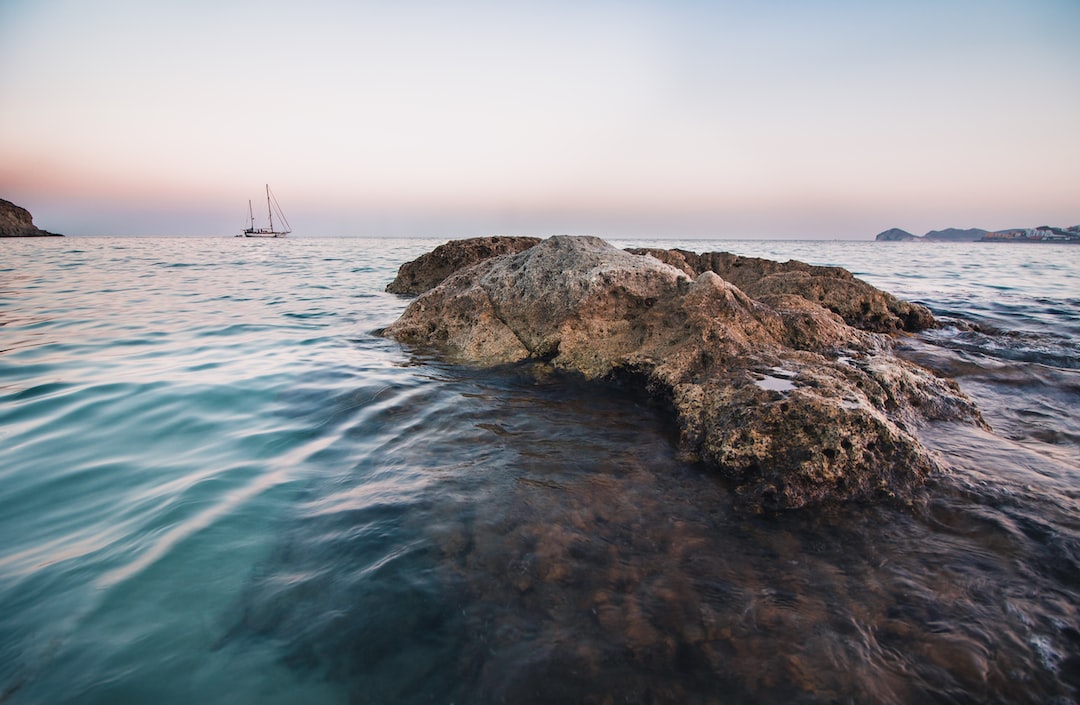
How fast is the hydrofoil racing yacht?
Hydrofoil racing yachts can achieve impressive speeds, with some models reaching over 50 knots (57.5 mph or 92.6 km/h). The F50 sailboat class, used in the SailGP series, holds the record for the fastest sailboat class, with a top speed of 52.2 knots (60 mph or 97 km/h).
What does a hydrofoil do to a boat?
A hydrofoil lifts the hull of a boat out of the water as it gains speed. This reduces the wetted area of the hull, minimizing drag and allowing the boat to achieve higher speeds. The lifting action of the hydrofoil also provides a smoother ride by reducing the impact of waves and chop.
Read more about “… Hydrofoil Catamaran: The Ultimate Guide to Foiling on Water”
How fast do hydrofoil boats go?
Hydrofoil boats can reach impressive speeds, depending on their design and purpose. Racing hydrofoil yachts can achieve speeds over 50 knots (57.5 mph or 92.6 km/h), while recreational hydrofoil boats can reach speeds of 20-30 knots (23-34.5 mph or 37-55.5 km/h) or more.
Why don’t boats use hydrofoils?
While hydrofoils offer significant advantages in terms of speed and efficiency, they also come with certain limitations. The complex design and higher costs associated with hydrofoils can be prohibitive for some boat owners. Additionally, the handling and control of hydrofoil boats require a certain level of skill and experience, making them less accessible to novice sailors.
Read more about “… Why do boats not use hydrofoils?”
Hydrofoil yachts have revolutionized the sailing experience, offering increased speed, improved efficiency, and a smoother ride. Whether you’re a competitive sailor looking for the thrill of high-speed racing or a recreational sailor seeking a more exhilarating sailing experience, hydrofoil yachts provide an exciting and innovative option.
Recommended Links:
- Hydrofoil History
- Advanced Hydrofoiling Techniques
- Hydrofoil Equipment Reviews
- How Do Hydrofoils Work on Boats? 2023
Reference Links:
- Sailing Hydrofoil – Wikipedia
- Gunboat Official Website
- Nacra Official Website
- SailGP Official Website
- America’s Cup Official Website
Now that you have a comprehensive understanding of hydrofoil yachts, it’s time to set sail and experience the thrill of foiling firsthand. Whether you’re racing on the high seas or cruising along the coast, a hydrofoil yacht will take your sailing adventures to new heights. Happy foiling!
Disclaimer: The information provided in this article is based on research and personal experience. Hydrofoiling™ is not affiliated with any specific brand or product mentioned in this article. Always consult with experts and follow safety guidelines when engaging in hydrofoil activities.
Review Team
The Popular Brands Review Team is a collective of seasoned professionals boasting an extensive and varied portfolio in the field of product evaluation. Composed of experts with specialties across a myriad of industries, the team’s collective experience spans across numerous decades, allowing them a unique depth and breadth of understanding when it comes to reviewing different brands and products.
Leaders in their respective fields, the team's expertise ranges from technology and electronics to fashion, luxury goods, outdoor and sports equipment, and even food and beverages. Their years of dedication and acute understanding of their sectors have given them an uncanny ability to discern the most subtle nuances of product design, functionality, and overall quality.
Related Posts
The ultimate guide to foiling boards: 12 secrets you need to know for an epic ride [2024] 🏄♂️.
- August 24, 2024

How to Get Up on a Hydrofoil: 12 Essential Tips for Beginners [2024] 🏄♂️
What is the physics behind foiling 10 eye-opening insights to elevate your ride [2024] 🌊✨.
- August 21, 2024
Leave a Reply Cancel Reply
Your email address will not be published. Required fields are marked *
Add Comment *
Save my name, email, and website in this browser for the next time I comment.
Post Comment
Trending now
BoatNews.com
The Nacra 17: an Olympic hydrofoil catamaran tamed by a mixed crew
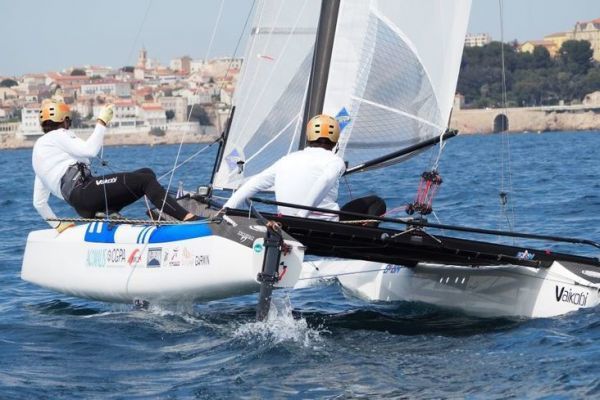
Since its introduction at the Rio Olympics in 2016, the Nacra 17 catamaran has attracted talented crews, drawn by the technicality of the support and the very high level of the circuit.
Evolutive design
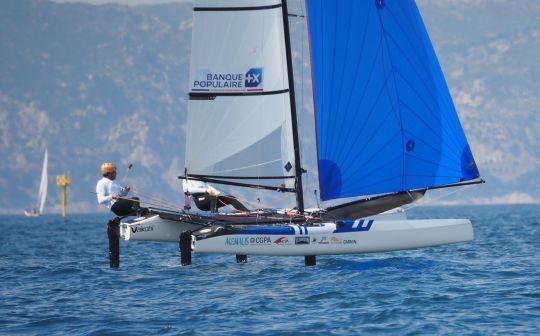
Launched in 2012, the Nacra 17 is the fruit of collaboration by architects Morelli and Melvin for builder Nacra Sailing International. With a length of 5.25 meters and a beam of 2.59 meters, its one-design hulls and arms are made of carbon-epoxy.
Upwind, it has an 18.65m2 sail plan, boosted by a 19.5m2 downwind spinnaker .
A first appearance at the 2016 Olympic Games
The Nacra 17 has been selected as the official Olympic multihull for 2016 in Rio, replacing the Tornado, which saw its last Games in 2008 in Beijing. It's worth noting that there were no catamarans at the London 2012 Olympic Games , which goes to show the level of expectation among racers to race multihulls again at the Olympics.
In 2017, the catamaran in the Nacra range underwent major modifications: it switched from curved daggerboards to C-shaped foils and rudders with load-bearing planes, becoming a fully flying boat. Its construction has also evolved, incorporating partial carbon hulls.
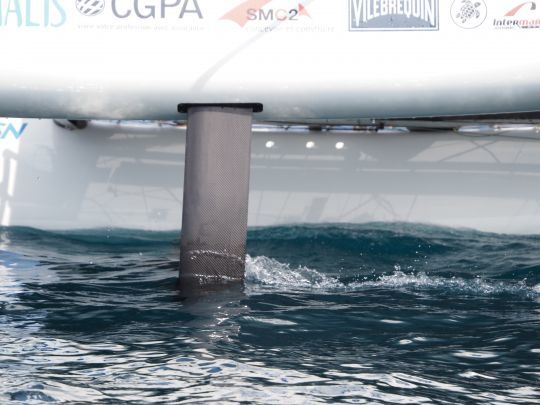
Today's most demanding sport catamaran
It's the only Olympic sailboat that not only sails archimedean, but also flies. Optimum crew weight is between 130 and 140 kg.
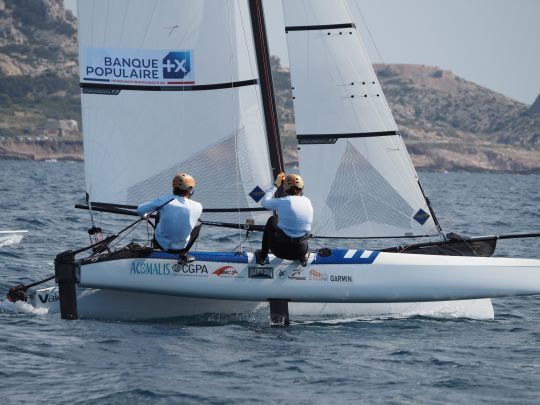
According to several trainers, this is currently the most demanding catamaran for its crew . Technical, complex and sensitive to the slightest adjustment, it demands great mastery from its crew .
Like most Olympic boats, the main components of the Nacra 17 are one-design. The crew and technical staff have discretion over the setting of the standing rigging and the incidence of the foils.
A mixed crew
Since its first appearance at the Games, the Nacra 17 has always been tamed by a mixed crew .
In Brazil , it was the duo of Billy Besson and Marie Riou who represented France, finishing in 5th place, a fine performance considering that Billy was suffering from a herniated disc.
In Tokyo 2020, Quentin Delapierre and Manon Audinetended in 8th place.
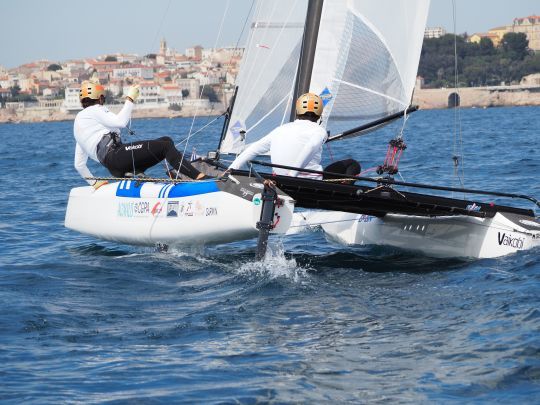

- FlySafe ® Foil Control
- iFLY Reviews
- Our Partners
- Distributors
Class Association
Enter your keyword.
Just enjoy high speed - foiling
” iFLY – Born to FLY “
Just enjoy foiling, ” high performance sailing “, ” we love speed “, ” join the adventure “.

iFLY15 – Technical SPECS
Length 4.63 m, 15 ft..
A Foiling Catamaran for 1-2 person(s) does not need to be any longer than this. The ancient rule that says you need length to achieve speed does not apply, as hulls do not touch the water at most times.
Width 2.50 m.
This width provides plenty of righting moment, still being road legal ato be transported in horizontal position without disassembly.
7.5 m mast / 11.2 sqm mainsail
7.5 m mast with 11.2 sqm deck-sweeper mainsail. – 8.5 m mast on iFLY RAZZOR Pro with bigger rig
Draft: 95 cm
Weight: 90 kg.
90 kg ready to sail. A very light boat, providing nonetheless excellent stability for everyday suitability.
Crew 1-2 - max.180kg
Flysafe® foil control.
T-Foils Main Foils and Rudders FlySafe automatic dynamic foil control Additional Option: Main Foil Differential >>>
Know More >>>
Different - Rig Options
LATEST DEVELOPMENT OF “DECK SWEEPING” MAINSAIL THE ROLLABLE HERU WING RIG LIGHT WIND FORESAIL «CodeF»
Full Carbon Hulls
Looking for the perfect setup for your foiling sailboat.
We can recommend the best iFLY setup and accessories for your boat. Get in touch for the ultimate sailing experience!
Performance
A great number of innovations all over the catamaran and the perfect match of all components allow controlled high-speed foiling experience. iFLY15 is full of innovations, e.g. in hull design, hydrofoils, rudders, automatic flight control system, two-layer wing trampoline, high performance rig…
HULL Design
full carbon – lightweight – performance design: Born to foil
High Performance Rig Options
LATEST DEVELOPMENT OF “DECK SWEEPING” MAINSAIL WORLD PREMIERE: THE ROLLABLE HERU WING RIG : WORLD PREMIERE: LIGHT WIND FORESAIL «CodeF». ALLOWS UPWIND FOILING (as well as other courses/points) ALREADY IN EXTREMELY LIGHT BREEZE. Know More >>>
Two Layer Trampoline
AERODYNAMIC INNOVATIVE WING TRAMPOLINE CREATING LIFT.
Full Carbon T-Foils
SCIENTIFICALLY DEVELOPED high-end foils for early take off, high speed and maximum stability.
flySafe® dynamic foil control system
The foils are controlled independently, dynamically and precisely on both sides by the flySafe® foil control system . This enables high performance sailing through stable flight. The unique foil control system of IFLY15 is a 7 years proven system developed by CEC Catamarans. Know More >>>
IFLY MAIN FOIL DIFFERENTIAL TECHNOLOGY
MDT FOIL CONTROL – iFLY rake control The sophisticated main foil differential is an active flight assistance – The Rake is adjustable while sailing. Advanced Rake Control is for the experienced, performance-oriented Catamaran sailors / pro sailors and is a feature on the iFLY RAZZOR Pro. Know More >>>
Innovations and more >>>
In the hand of the experienced sailor, iFLY15 is a high-performance racing machine. STABILITY IS NOT CONTRADICTORY TO HIGH PERFORMANCE OR SPORTINESS , on the contrary, it is a prerequisite for safe reaching and maintaining constant high speeds. Stable flight allows the sailor to concentrate on the course, on the wind, as well as on opponents and strategy – rather than permanently getting distracted by working on the foiling balance.
EARLY TAKE OFF IN WINDS AS LOW AS 2Bft. / 6 KNOTS , by combining the innovative “KickOff” foil control with a trampoline that provides boost and with the latest generation of rig and foils.
BOAT SPEEDS FAR BEYOND DOUBLE WIND SPEED CAN BE ACHIEVED . Enjoy high speed foiling with top speeds far beyond 25 knots – in ideal conditions up to 30 knots.
CONTROLLED FOILING EVEN IN THE UPPER WIND RANGE BEYOND 22KNOTS OF WIND SPEED – supported by the new FlySafe® Automatic Foil System.
FOILING PLEASURE AND PERFORMANCE ALSO IN CHOPPY WATERS
FREEDOM ! FLYING SOLO OR OPTIONAL WITH CREW . You have the choice. No manhunt for crew. But still enjoy the opportunity of taking a friend or family to fly with you. Up to 140kg of crew weight. (To keep the boat and especially the mast light, we specified the iFLY15 components intentionally not for double trapeze.)
NO HOISTING AND LOWERING OF DAGGERBOARDS while sailing. (Only for beaching or in shallow waters.)
FREEDOM TO SWITCH BETWEEN FLYING MODE OR SAILING AS A CONVENTIONAL CATAMARAN (with at least the leeward hull touching the water). Within seconds iFLY15 can be switched to Non-Flight mode, even while sailing. In that mode, iFLY15 will not take off, but the foils will still create lift and give an extra agile sailing behavior, which is on the same time very stable as rudder Foils will avoid pitch poling. Non-Flight mode is providing additional security in extreme high wind speeds. It is also useful for less experienced sailors or in all situations, where taking off is undesirable (e.g. in the harbor or while towing…).
EASY TO LEARN FLYING BY AVERAGE SKILLED AND TRAINED SAILORS
EASY BEACHING AND SLIPPING , as simple as with any conventional beach catamaran by using a standard catamaran beach trolley. Foils remain flat under the keel, with the daggerboard lifted as on a conventional catamaran.
SIMPLE TO DISASSEMBLE PLATFORM . Width of 2.50m is also road legal in most countries for horizontal transport without disassembly.
DAGGERBOARDS CAN BE PLUGGED IN FROM ABOVE and Foils securely anchored from below with one central screw.
FAST SET-UP OF THE iFLY15 FROM ROAD TRAILER TO SAILING . Simple rigging the mast, no genacker boom, no foresail, no spi.
SILENT AND CALM PLANING ABOVE THE WAVES . Flight height of up to 90cm, avoiding even high waves below.
EASY TO FOIL THE JIBE (without landing). Stable maneuvers are made easier by the fact that the four T-Foils always remain in the water.
« INTERNATIONAL FORMULA 15 FOIL » Class Association. The new development class for FOILING, SINGLE HANDED on MULTIHULLS. Multi manufacturer class in the tradition of a Formula18, A-Class or international Moth. Enables large regatta fields and evolution of the boats, following the technical progress (which is especially essential in the case in Foiling). Strict regulations to avoid uncontrolled exaggerated development.
Contact : [email protected]
Catamaran Europe Central
The iflysail team, is looking forward to your message, more to know about ifly foiling , interesting tech, high performance rig options >>>, flysafe® dynamic foil control system >>>, ifly main foil differential technology >>>.
MDT FOIL CONTROL – iFLY rake control
News and More
Ifly foiling experience >>>, press articles >>>, events >>>.

- Subscribe Now
- Digital Editions

Best hydrofoil boats: 6 of the most spectacular foiling motorboats money can buy
- Electric boats
- Top stories
Foiling technology has really taken off in the past few years. We pick out 6 of the best hydrofoil boats you can buy right now…
With its roots in the 19th century, foiling technology is as old as the hills, but in the past five years we’ve noticed an explosion of hydrofoil boats coming onto the market.
In part inspired by the foiling raceboats of the America’s Cup , the popularity of foiling is easy to understand – fuel efficiency gains are substantial, noise is almost eliminated (particularly if your foiling boat also happens to be an electric boat ) and they look as cool as a snowman in a freezer!
To help you understand the dizzying array of foiling boats available right now, we’ve put together the following guide to what we think are the most promising designs out there.
6 of the best hydrofoil boats

SEAir foiling RIB
Founded in 2016, French yard SEAir builds foiling RIBs, having been inspired by the speed of foiling racing yachts.
We tested their 5.5m model back in 2018 and since then they have expanded their range to cover superyacht chase boats, commercial and military vessels.
Our tester recorded a top speed of 32 knots, with the foils doing their best work at around 20 knots, but SEAir claims that 42 knots is possible in the right conditions.
Read more about the SEAir foiling RIB
Article continues below…

Spirit Yachts launches spectacular long-range electric flying boat
BMW launches new ICON electric boat at Cannes Film Festival
The Cannes Film Festival has seen the launch of the new ICON electric boat. Created by BMW in collaboration with

A dual helm set-up allows the boat to be piloted from the bow or the cockpit. Photo: Guillaume Plisson
Enata Foiler
Dubai-based Enata Marine added a healthy dose of glamour to the world of foiling boats in 2018 with the launch of its Foiler.
In addition to a superyacht tender-worthy exterior, this 32fter includes a bow window for spectacular views while underway.
A 40-knot top speed and a 190nm range makes this a very appealing option, although the premium price tag of $938,000 may put some off.
Read more about the Enata Foiler

Princess R35
When British boatbuilding giant Princess Yachts got in on the foiling boat game in 2019 with a 35ft carbon-fibre dayboat, we knew that things had really taken off.
While the foil-assisted R35 may not have the spectacular cruising-above-the-waves appeal of some other foiling boats, it is highly efficient, beautifully designed (in collaboration with Pininfarina) and handles like nothing else we’ve ever driven.
In our review, we praised its rare combination of agility, refinement and stability, with spray kept in check impressively at high speeds.
Read more about the Princess R35

The foiling Candela C-8 is the first boat to use Candela’s proprietary C-POD, but bigger craft will follow later
Candela C-8
Swedish firm Candela burst onto the scene in 2021 with its debut, the Candela C-7 , which was billed as the world’s first electric foiling boat, but it was the 2022 launch of the Candela C-8 that really moved the game on.
Available with a 69kWh battery, adapted from the Polestar 2 electric car, owners can expect a range of 57nm at 22 knots, more than enough for dayboat use.
The consumption figures are truly staggering, with Candela’s figures suggesting that the C-8 is more than 12x more efficient than an equivalent 300hp outboard powered sportsboat.
Read more about the Candela C-8

The electric Iguana is capable of three knots on the land and 30 knots at sea
Iguana Foiler
Not content with being at the forefront of the amphibious boats market with its caterpillar-track offering, French yard Iguana has set its sights on the world of foiling too.
Announced last year, the Iguana Foiler will be powered by the world’s most powerful electric outboard engine, the 300hp Evoy Storm .
Having tested both the engine and the boat separately, we can’t wait to see the result when they come together with the added advantages of foiling technology. Watch this space…
Read more about the Iguana Foiler

The foils lift up at slow speeds to reduce the draft
Mantaray M24
Another exciting model in the hydrofoil boats pipeline, this 24ft runabout is particularly interesting is its simplicity. Unlike its main foiling rival, the Candela C-7, the Mantaray M24 requires no complicated electronics to ‘fly’.
Instead it uses the builder’s patented mechanical hydrofoil system, which it has trademarked as Dynamic Wing Technology or DWT. The technology is said to be the result of ten years’ development work and uses a retractable T-foil in the bow and H-foil amidships that self-stabilise mechanically.
This allows it to lean naturally into corners and ride serenely over waves without relying on a network of sensors and algorithms to monitor and adjust the foils. If it proves effective this could drastically reduce the cost and complexity of foiling boats, while simultaneously increasing reliability.
Read more about the Mantaray M24
It doesn’t end here, with fascinating one-off projects from Spirit Yachts and BMW on the water, it’s clear that foiling has a huge potential for transforming the world of boating.
Read more about hydrofoil technology
Maserati Tridente: The First Maserati-Branded Motor Boat, and It’s Electric
Witness appeal after reports of a motor boat collision, james bond’s birthday gift to the rnli, latest videos, watch: parker sorrento sea trial: 50-knot cruiser with a killer aft cabin, watch: virtue v10 sea trial: €272k weekender, how to mark your anchor chain: 6 top tips from our expert, watch: galeon 560 fly sea trial – the best galeon flybridge you can buy.

- Green Propulsion
- Renewable Energy
- Energy efficiency
- Sustainable materials
- Eco Insights
- News & Events
- Sunreef News Magazine
- Press About Sunreef

- 60 Sunreef Power
- 70 Sunreef Power
- 80 Sunreef Power
- 100 Sunreef Power
- Sunreef Supreme Power
- Sunreef Ultima Range
- Sunreef 44 Ultima
- Sunreef 55 Ultima
- Sunreef 66 Ultima
- Sunreef 77 Ultima
- Sunreef 88 Ultima
- Sunreef fleet

- Sunreef Zero Cat
- Sunreef 100
- Sunreef Fleet

- Sunreef 35M
- Sunreef 43M
- 49M Sunreef Power
- 210 Sunreef Power Trimaran
- Sunreef Explorer
- 40M Sunreef Explorer
- 40M Sunreef Explorer Eco
- 50M Sunreef Explorer
- Superyachts Fleet
Sunreef Yachts Presents the World First Hydrofoil System for Luxury Open Catamarans

Catamarans offer several specific features that make them a perfect alternative for traditional yachts, e.g. a bigger living space (sometimes even twice as big as on a single-hull vessel), excellent stability and a very long cruising range. However, enthusiasts of motor vessels choose catamarans primarily for their high performance.
In order to meet needs and expectations of our customers, Sunreef’s naval architects team decided to develop a system of retractable hydrofoils that will enable luxurious Sunreef vessels to attain a maximum speed up to 70 knots and literally fly over the surface of water. Such a solution is the best choice for all those who want to fully exploit the potential offered by power boats.
Hydrofoils in catamarans are used to reduce drag that directly affects the speed of a vessel. A vessel fitted with hydrofoils is lifted out of the water which significantly decreases drag, consequently allowing for greater speeds. Additionally, due to excellent stability of catamarans (ensured by two independent hulls), a vessel is adequately balanced without the need to employ complicated stabilizing systems. As a result, both helmsmen and passengers are offered the ultimate comfort and safety even at considerable speeds (such a combination is not possible in case of standard single-hull vessels).
The first model fitted with hydrofoils will be the Sunreef 40 H – a 40-feet motor catamaran of an open type. A specialist in luxurious, custom-made, multi-hull vessels, the Sunreef Yachts shipyard is going to present a perfectly finished catamaran with sleek, sporty silhouette that will be the ideal choice for everyone who values perfect design and top performance.

Previous Post Sunreef Yachts Announces Its Presence at the Monaco Yacht Show 2014
Next post sunreef yachts presents the new sunreef 74 sailing catamaran.
Comments are closed.
SUBSCRIBE TO OUR NEWSLETTER
- Sailing Yachts
- Power Yachts
- Superyachts
- Making a Change
- Green Concept
- Energy Efficiency
- Sustainable Materials
Copyright © 2024 Sunreef Yachts . All rights reserved.
- Whistleblowing
- Privacy Policy

Sunreef Venture S.A.
Sunreef Yachts Shipyard
ul. Tarcice 6
80-718 Gdańsk, Poland
+48 58 769 77 77

Service Locator
- Angler Endorsement
- Boat Towing Coverage
- Mechanical Breakdown
- Insurance Requirements in Mexico
- Agreed Hull Value
- Actual Cash Value
- Liability Only
- Insurance Payment Options
- Claims Information
- Towing Service Agreement
- Membership Plans
- Boat Show Tickets
- BoatUS Boats For Sale
- Membership Payment Options
- Consumer Affairs
- Boat Documentation Requirements
- Installation Instructions
- Shipping & Handling Information
- Contact Boat Lettering
- End User Agreement
- Frequently Asked Questions
- Vessel Documentation
- BoatUS Foundation
- Government Affairs
- Powercruisers
- Buying & Selling Advice
- Maintenance
- Tow Vehicles
- Make & Create
- Makeovers & Refitting
- Accessories
- Electronics
- Skills, Tips, Tools
- Spring Preparation
- Winterization
- Boaters’ Rights
- Environment & Clean Water
- Boat Safety
- Navigational Hazards
- Personal Safety
- Batteries & Onboard Power
- Motors, Engines, Propulsion
- Books & Movies
- Cockpit Confessions
- Communication & Etiquette
- Contests & Sweepstakes
- Colleges & Tech Schools
- Food, Drink, Entertainment
- New To Boating
- Travel & Destinations
- Watersports
- Anchors & Anchoring
- Boat Handling
- ← Technology
Hydrofoils: Boats That Fly
Advertisement
Hydrofoils make everything from water skis to sailboats to giant ferries faster (much faster). But how the heck do they work?
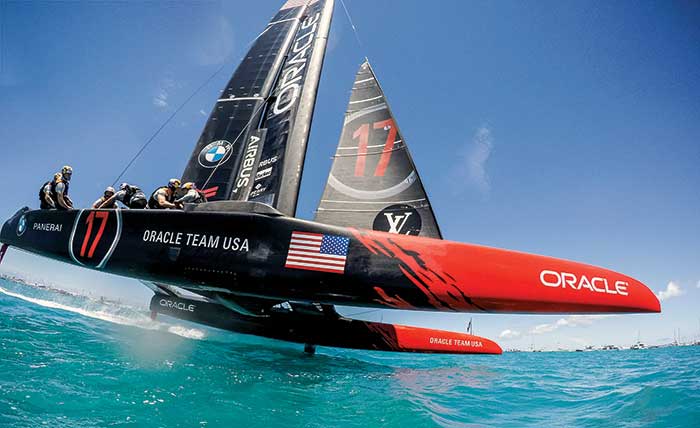
Oracle Team USA's AC50 "flying" at nearly 50 mph. (Photo: Ricardo Pinto)
Ever wonder why a sleek, powerful recreational boat is not even as fast as a typical economy car? It has to do with friction. An economy car needs a little over 100 horsepower to speed by at 100 mph, but pushing a boat through the water that fast takes several hundred horsepower. The reason is that water is almost 800 times denser than air.
Imagine standing on your dock in a 10-knot wind — it's not hard to do. Now imagine being in a river trying to stand up to a 10-knot current. The water is so much denser that no matter how strong you are, you'd be swept away. A boat hull has to push through all that dense water while a car can slip through the air much easier.
Planing boats are able to go faster than displacement boats because they lift part of their hull out of the water as they race over their bow wave, but there's still a lot of friction from the water on the rest of the hull. If you could get the hull all the way out of the water, you'd eliminate that friction, and the boat could go faster with the same amount of power.
The Science
Most of us have a pretty good understanding of how an airplane flies. As air flows over and under the wings (also called airfoils), it creates lift. Once an airplane is going fast enough, the lift that the wings create allow it to rise above the earth.
If you were to mount a wing or two (called hydrofoils) under a boat, all that dense water can be put to good use by pushing the boat's hull out of the water. Then friction only acts on the small foils, not on the whole hull, which is why a 130-foot hydrofoiling sailboat can "fly" at over 50 knots. Powerboats have added friction from the propulsion system that has to remain in the water, but even then, large hydrofoiling ferries can exceed 45 knots.
Speed is not the only advantage that hydrofoils give boats. Because the hull is out of the water, all the energy from waves that would normally pound against the boat pass harmlessly underneath it, creating an eerily smooth ride. Even so, hydrofoiling is typically best in somewhat protected waters.
Don't look for hydrofoils on your next runabout anytime soon because they're much more difficult to engineer and typically triple the cost of a boat. The good news is that there are other ways to 'foil that are affordable — see "Experience Hydrofoiling For Yourself" at below.
Experience Hydrofoiling For Yourself
Hydrofoil kiteboards.
If you've even seen a kiteboard zooming in a strong breeze, you know they're plenty fast. Add a hydrofoil, and suddenly you add a new dimension. These boards take lots of skill and practice to master, but the ride is said to be much smoother and even faster than a conventional kiteboard. Cost starts at around $1,000.
Hydrofoil Waterskis
These single-ski hydrofoils are really a sit-on-ski, and once you've mastered the technique, the foils will lift you up and you'll be "flying." Unlike conventional skis, these aren't designed for speed, and 18 mph is where they typically "liftoff' and suggested top speed is about 25 mph. It's also important not to ski in shallow water due to the depth of the foils. Cost is typically $1,500 and up.
Hydrofoil Windsurfers
Not content to take a surfboard and add a sail, windsurfers developed foils that allow the board to "levitate." The biggest advantage is the smoothness of the ride — a real benefit because these rigs usually sail in very strong winds with plenty of chop. Cost is about $2,500 to get started.
Hydrofoiling Small Sailboats
You don't have to spend millions on a boat like the America's Cup racers if you want to hydrofoil. The Waszp costs about $10,000, though even for dinghy racers, there's a learning curve to get these boats on their foils, with speeds up to 27 mph.
Note that most companies suggest wearing a helmet when using foiling products because of the speeds achievable and the hard, sharp foils these devices have.
Foiling The Competition
America's Cup boats are often what people think of when they hear the word "hydrofoil." Hal Youngren, an aeronautical engineer and one of the designers for the 2013 and 2017 America's Cup racers, says the difference in speed that foils make is impressive. The fastest nonfoiling catamarans in previous races could barely reach 35 knots, while the 2017 foiling cats hit 50 knots. Youngren says that these 50-foot cats are able to lift their hulls completely out of the water using only about three-quarters of a square meter of foil area (about the size of a medium-sized TV). Below about 15 knots, he says, the boats sail much like a nonfoiling boat with hulls in the water, but once over that speed, the boats start to "fly" and their speed dramatically increases.
The America's Cup Class AC75 Boat Concept Revealed
An exciting new era in America's Cup racing was unveiled in November 2017 as the concept for the AC75, the class of boat to be sailed in the 36th America's Cup is released illustrating a bold and modern vision for high performance fully foiling monohull racing yachts.
The America's Cup AC75 Boat Concept Revealed
The Emirates Team New Zealand and Luna Rossa design teams spent the previous four months evaluating a wide range of monohull concepts. Their goals have been to design a class that will be challenging and demanding to sail, rewarding the top level of skill for the crews; this concept could become the future of racing and even cruising monohulls beyond the America's Cup.
The AC75 combines extremely high-performance sailing and great match racing with the safety of a boat that can right itself in the event of a capsize. The groundbreaking concept is achieved through the use of twin canting T-foils, ballasted to provide righting-moment when sailing, and roll stability at low speed.
An underlying principle has been to provide affordable and sustainable technology "trickle down" to other sailing classes and yachts. While recent America's Cup multihulls have benefitted from the power and control of rigid wing sails, there has been no transfer of this technology to the rigs of other sailing classes. In tandem with the innovations of the foiling system, Emirates Team New Zealand and Luna Rossa are investigating a number of possible innovations for the AC75's rig, with the requirement that the rig need not be craned in and out each day. This research work is ongoing as different concepts are evaluated, and details will be released with the AC75 Class Rule before March 31, 2018.
The America's Cup is a match race and creating a class that will provide challenging match racing has been the goal from the start. The AC75 will foil-tack and foil-gybe with only small maneuvering losses, and given the speed and the ease at which the boats can turn the classic pre-starts of the America's Cup are set to make an exciting comeback. Sail handling will also become important, with cross-overs to code zero sails in light wind conditions.
A huge number of ideas have been considered in the quest to define a class that will be extremely exciting to sail and provide great match racing, but the final decision was an easy one: the concept being announced was a clear winner, and both teams are eager to be introducing the AC75 for the 36th America's Cup in 2021. — AmericasCup.com
Related Articles
The truth about ceramic coatings for boats.
Our editor investigates the marketing claims of consumer-grade ceramic coatings.
Fine-Tune Your Side Scan Fishfinder
Take your side-scanning fishfinder off auto mode, and you’ll be spotting your prey from afar in no time
DIY Boat Foam Decking
Closed-cell foam flooring helps make boating more comfortable. Here’s how to install it on your vessel
Click to explore related articles
Charles Fort
Contributing Editor, BoatUS Magazine
Charles Fort is BoatUS Magazine's West Coast Editor. He often writes local news items for BoatUS Magazine's Waypoints column and contributes to Reports, in-depth tech features in every issue written to help readers avoid accidental damage to their boats. He is a member of the National Association of Marine Surveyors, he's on ABYC tech committees, and has a 100-ton U.S. Coast Guard license. He lives in California.
BoatUS Magazine Is A Benefit Of BoatUS Membership
Membership Benefits Include:
Subscription to the print version of BoatUS Magazine
4% back on purchases from West Marine stores or online at WestMarine.com
Discounts on fuel, transient slips, repairs and more at over 1,200 businesses
Deals on cruises, charters, car rentals, hotel stays and more…
All for only $25/year!
We use cookies to enhance your visit to our website and to improve your experience. By continuing to use our website, you’re agreeing to our cookie policy.

IMAGES
COMMENTS
Sailing used to be considered as a rather sedate pastime. But in the past few years, the world of yacht racing has been revolutionised by the arrival of hydrofoil-supported catamarans, known as ...
With razor-sharp hydrofoil catamarans that help them hit speeds of 60 miles an hour, the athletes of SailGP are pushing the limits of physics and human endur...
The Flying Phantom catamaran is quite arguably the future of sailing. It's a two-person vessel powered by the wind and a unique hydrofoil design. The hydrofo...
Teams must therefore work together to fly as high as possible without flying too high and crashing into the water, rising speed and losing speed in SailGP's high pressure racing. The F50's cutting edge technology is evident in its status as the first boat to hit 99.94 km/h during racing - and it has a top speed of over 100 km/h.
Hydrofoil catamarans can reach speeds of up to 40 knots (46 mph) or more, depending on the design and conditions. The foils on a hydrofoil catamaran can lift the hulls out of the water, reducing drag and allowing for a smoother and faster ride. Hydrofoil catamarans are used for various purposes, including racing, recreational sailing, and even ...
How SailGP's foiling F50 catamarans sail so much faster than the wind. Jonathan Turner. January 8, 2023. Arguably the most technologically advanced sailboats on the planet right now, the one-design SailGP F50 foiling catamarans are capable of breathtaking speeds - at times, reaching four times the velocity of the wind that drives them.
In SailGP, five-member crews representing six countries race identical F50 foiling catamarans in the world's most famous harbours. Complex control systems an...
Unique design enables top performances. The F1x A-class foiling catamaran is the ultimate reflection of our current design language. The aerodynamic design accentuates the performance qualities of this super fast foiling racing boat. The sophisticated deck plan provides clear control and minimal air resistance. The rudders and daggerboard foils ...
The future for sailing hydrofoils is surely about more than just racing. At least, that was the view of one owner who, having witnessed the America's Cup foiling catamarans, saw a big opportunity.
With razor-sharp hydrofoil catamarans that help them hit speeds of 60 miles an hour, the athletes of SailGP are pushing the limits of physics and human endurance. F50 Hydrofoils: Racing The World ...
The F50 is a one-design foiling catamaran used in the SailGP race series. The name is an abbreviation of "Foiling" and "a hull length of 50 feet". [1]The F50s are adapted from the AC50s used in the America's Cup, with modifications including new control systems and modular wingsails. [2] The F50s are one of the fastest racing classes in history, with a predicted top speed of 52.2 knots (96.6 ...
The Foil Cat holds 400 gallons of fuel and with twin Mercury 400 Verado engines, has a 600-700-mile range, cruising at an easy 32 mph. That horsepower and speed provides an economical 2 mpg burn. The amidship location of the 28" foils come into play as the boat planes, balancing the amount of boat in the water, both foils and propulsion units ...
The new foiling catamaran design is the result of Persico's strategy to translate knowledge the yard gains from its work in aerospace, IMOCA 60 and America's Cup spheres into very…
The flight control system, combined with numerous fine-tuned innovations, ensures safe foiling even in strong winds and rough seas.. Stable flight attitude allows pushing hard, so in good conditions, iFLY reaches high boat speed beyond 30 knots in a controllable way. IFLY15 offers freedom to fly alone or in pairs.
AC72 and AC45f/AC50: These hydrofoil catamarans were used in the America's Cup, showcasing the cutting-edge technology and innovation in the world of hydrofoil yachts. These yachts pushed the boundaries of speed and performance, captivating sailing enthusiasts worldwide. ... Racing hydrofoil yachts can achieve speeds over 50 knots (57.5 mph ...
Hydrofoiling wingsail catamaran 17. A sailing hydrofoil, hydrofoil sailboat, or hydrosail is a sailboat with wing-like foils mounted under the hull.As the craft increases its speed the hydrofoils lift the hull up and out of the water, greatly reducing wetted area, resulting in decreased drag and increased speed. A sailing hydrofoil can achieve speeds exceeding double and in some cases triple ...
The Flying Phantom catamaran seems to levitate above the water as it hydrofoils. "It's like removing the handbrake - suddenly everything gets smoother and faster in pure silence.". This ...
A mixed crew. Since its first appearance at the Games, the Nacra 17 has always been tamed by a mixed crew. In Brazil, it was the duo of Billy Besson and Marie Riou who represented France, finishing in 5th place, a fine performance considering that Billy was suffering from a herniated disc. In Tokyo 2020, Quentin Delapierre and Manon ...
By Zuzana Prochazka. January 31, 2019. In 2013, the world sat up and took notice of foiling boats mostly due to the much-promoted America's Cup. The AC72 catamarans flew across our TV screens with great speed and grace, hardly touching the water. These high-priced models achieved 40 knots in 17 knots of breeze with their T-shaped rudders and ...
We can recommend the best iFLY setup and accessories for your boat. A great number of innovations all over the catamaran and the perfect match of all components allow controlled high-speed foiling experience. iFLY15 is full of innovations, e.g. in hull design, hydrofoils, rudders, automatic flight control system, two-layer wing trampoline, high ...
SEAir foiling RIB. Founded in 2016, French yard SEAir builds foiling RIBs, having been inspired by the speed of foiling racing yachts. We tested their 5.5m model back in 2018 and since then they have expanded their range to cover superyacht chase boats, commercial and military vessels.. Our tester recorded a top speed of 32 knots, with the foils doing their best work at around 20 knots, but ...
Sunreef Yachts Presents the World First Hydrofoil System for Luxury Open Catamarans. September 15, 2014. Catamarans offer several specific features that make them a perfect alternative for traditional yachts, e.g. a bigger living space (sometimes even twice as big as on a single-hull vessel), excellent stability and a very long cruising range.
Hydrofoil Kiteboards. ... The fastest nonfoiling catamarans in previous races could barely reach 35 knots, while the 2017 foiling cats hit 50 knots. ... have been considered in the quest to define a class that will be extremely exciting to sail and provide great match racing, but the final decision was an easy one: the concept being announced ...